Founded in 1955, the Beaux Arts Trio has set the standard for performance of the piano trio literature for forty-six years. Before them, the standard had been set by the tours and recordings made in the 1920s by Alfred Cortot, Jacques Thibaud and Pablo Casals. They were great virtuosos who got together to explore the piano trio repertory. The Beaux Arts Trio was the first group whose members wholly immersed themselves in their literature, just as the great string quartet groups had done.
The one constant throughout their existence has been the anchor of pianist Menachem Pressler. Until 1987, the cellist was Bernard Greenhouse. The founding violinist was Daniel Guilet, who was replaced in 1969 by Isidore Cohen. He made most of the group’s extensive series of Philips recordings, including a classic and pioneering complete Haydn piano trio set. In 1987, cellist Peter Wiley replaced Greenhouse; violinist Ida Kavafian replaced Cohen in 1992. Kavafian and Wiley left the trio in 1998 and can now be heard as part of the Opus One Piano Quartet, which debuted locally on the first Durham Chamber Arts concert of the season. The new violinist is Young Uck Kim, who has made a number of fine chamber music recordings for Sony (including Dvorak piano trios with Emmanuel Ax and Yo-Yo Ma). The new cellist, Antonio Meneses, has recorded for Deutsche Grammophon.
I first discovered the Classical Concert Series in Moore County when I attended a performance of the Borromeo String Quartet in January 1999. At that time the concerts were held in the intimate Sunrise Theater in Southern Pines, which might have seated 350-400. In the 1999-2000 season they had only 200 subscribers. They sold out their 2000-2001 season three weeks before the opening and because of demand moved the series to Owens Auditorium on the Sandhills Community College, which has seating for nearly 700 and generous parking nearby. Martha Hall and the series board should be proud of the most successful and spectacular growth of a classical series in the Sandhills. Their experience should be a model for others. There are too many empty seats in many Triangle series. Highlights of past seasons were the Spoleto Festival USA Chamber Music Tour with Charles Wadsworth and the ever-popular Eroica Piano Trio. Another highlight of this season will be the only area appearance by the Emerson String Quartet in March. Check our calendar for more information. Use the Community College’s web page (at http://www.sandhills.cc.nc.us/ [inactive 5/04]) to find directions; it has a straight link to a correct Mapblast guide.
After a fine dinner and good fellowship, I arrived at Owens Auditorium on October 18 with only ten minutes to spare. The hall, which was at least 75% full, has a trapezoid shape with good sight lines and roomy, comfortable chairs. The programs had full notes on the music and the musicians. With the addition of a shell, the acoustics were fine. The program consisted of Mozart’s Trio in C, K.548, Beethoven’s Trio in E-flat, Op. 1, No. 1, and the Trio in B, Op. 8, by Brahms, in its usual revised version.
Among the chamber music gems of Mozart, the piano trios are his least precious stones. My favorite crib, Melvin Berger’s Guide To Chamber Music, covers only K.542. K.502 has a nice slow movement but made little impression upon me. The Beaux Arts Trio played it with a great deal of style. Pressler played with the Steinway’s lid fully up but judged his dynamics so minutely that he never overpowered his colleagues. Considering their unusually restrained dynamics throughout, this was quite an accomplishment. I found Kim’s violin tone darker than I would have expected. In the Mozart and the other two works, the bowing and phrasing of the two string players were unusually closely matched and both blended well with Pressler. All this restraint combined to leave me with the impression of an older, “porcelain” style of interpretation, but to tell the truth there isn’t much that anyone could have done to make this trio a hit. It’s too bad that they didn’t program any Haydn since the Beaux Arts did so much to bring those trios to light.
I was glad for a chance to hear really early Beethoven. The opening melodic figure was characterized by upward-rushing broken chords known as “Mannheim Rocket,” so called because it had been frequently used by mid-18th century composers connected with the Mannheim Court to add a special brilliance to their music. The interplay of parts toward the end of the Allegro was spirited. The dynamically restrained solo piano opened the adagio. The last two movements were much more rambunctious and engaging.
Since April Fool’s Day, I have heard at least six performances of Brahms’s First Piano Trio. Although in its revised version the Trio is an intense youthful piece, tightened and partially reworked by a more reserved and experienced composer late in life, all of these earlier performances brought out the full heat of youthful passion. The Beaux Arts played the Trio mostly well, absent a few clinkers, but my major reservation was that the restraint in dynamics before intermission was carried over into the Brahms. That said, music is the ultimate performance art, so it was interesting to hear a very autumnal view far removed from the general range. To exaggerate, it was as if the subject of Richard Strauss’ “Death and Transfiguration” had been reflecting upon the Op. 8 Trio!
Despite some backstage gossip, I was pleased to find that pianist Pressler still has considerable skills as a pianist and interpreter. He is well into his 80s so a few missed notes were not to be unexpected but they were far from being a cause of worry.
The Moore County series is worth the attention of all Triad and Triangle music lovers. Although well attended, there is still room for the eager concertgoer.











